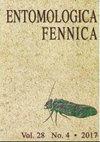Feeding on the roof of the world: the first gut content analysis of very high altitude Plecoptera
Q3 Agricultural and Biological Sciences
引用次数: 3
Abstract
The biology of Plecoptera from high altitude Himalayan freshwaters is almost unknown. Very few and sporadic studies have been devoted to these insects, and exclusively with a taxonomic approach. We provide information on the feeding of Capnia nymphs from three lakes localized above 4,800 m a.s.l. (NE Nepal). Nymphs from these high altitude lakes feed mainly on fine detritus, acting as collector- gatherers, with the accidental ingestion of mineral matter, mostly in larger specimens. It is likely that the harsh environmental conditions in our study area create an environment unfavorable to both the allochthonous input of coarse particulate organic matter (such as terrestrial leaves) and the autochthonous input related to aquatic primary productivity, so that these nymphs feed on small organic particles that originates mainly from the catchment.在世界屋脊上取食:高海拔翼翅目昆虫的首次肠道成分分析
来自喜马拉雅高海拔淡水的翼翅目生物几乎是未知的。很少有零星的研究专门用于这些昆虫,并且专门采用分类学方法。我们提供了来自尼泊尔东北部海拔4800米以上的三个湖泊的卡帕尼亚若虫的摄食信息。来自这些高海拔湖泊的若虫主要以细小的碎屑为食,作为收集者,偶然摄入矿物质,主要是在较大的标本中。研究区恶劣的环境条件可能既不利于粗颗粒有机物(如陆生树叶)的外来输入,也不利于水生初级生产力的本地输入,因此若虫以主要来自流域的小有机颗粒为食。
本文章由计算机程序翻译,如有差异,请以英文原文为准。
求助全文
约1分钟内获得全文
求助全文
来源期刊

Entomologica Fennica
生物-昆虫学
CiteScore
1.20
自引率
0.00%
发文量
0
审稿时长
>12 weeks
期刊介绍:
Cessation.Information not localized
 求助内容:
求助内容: 应助结果提醒方式:
应助结果提醒方式:


